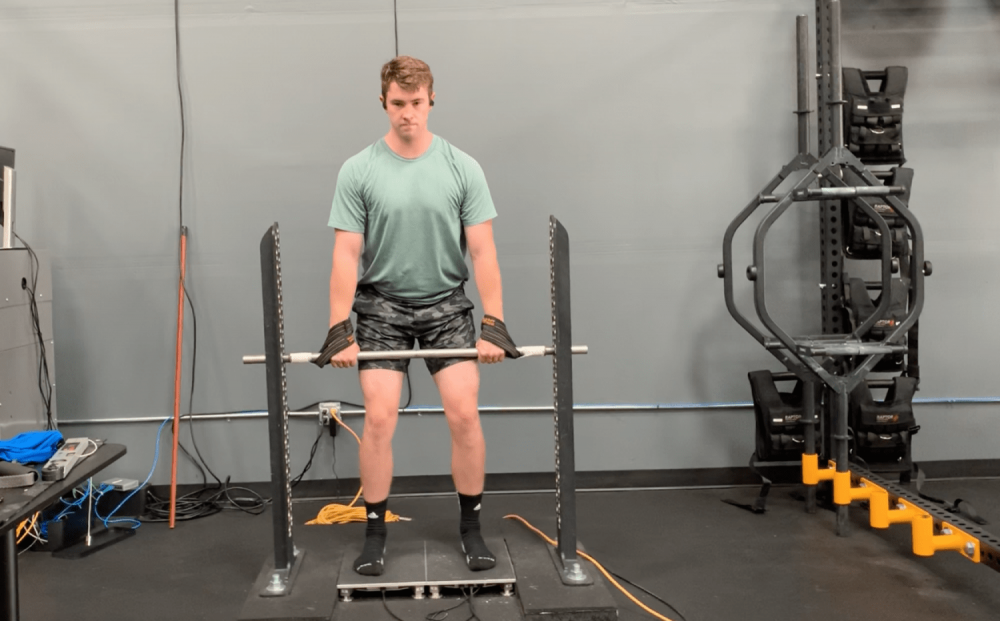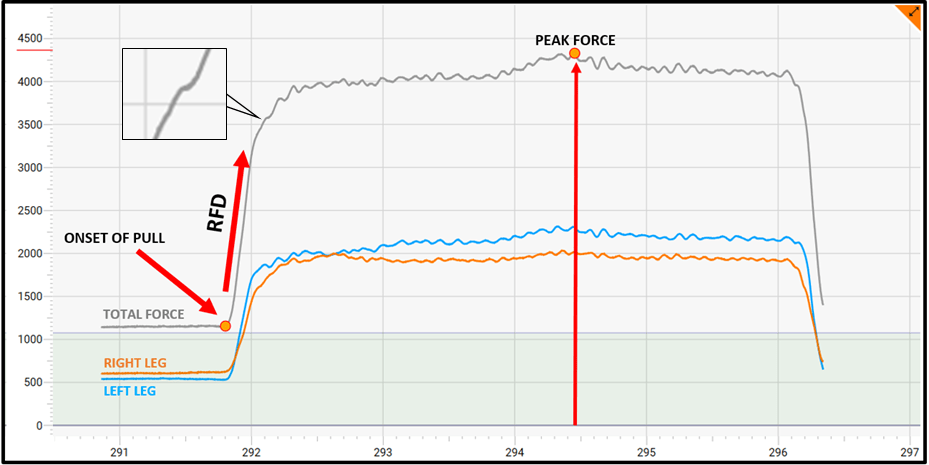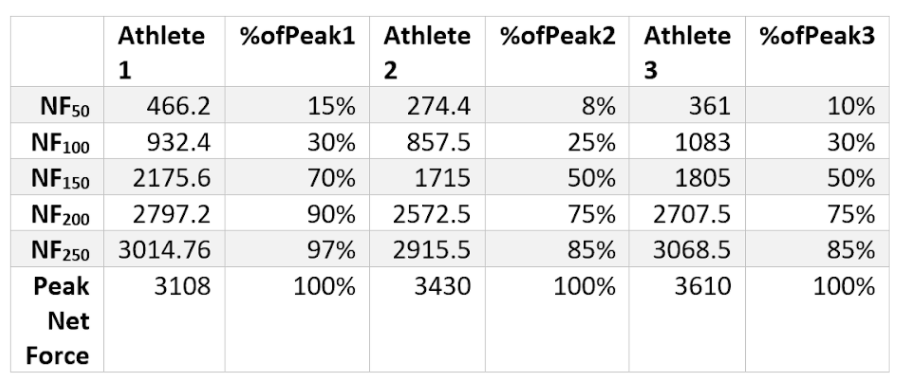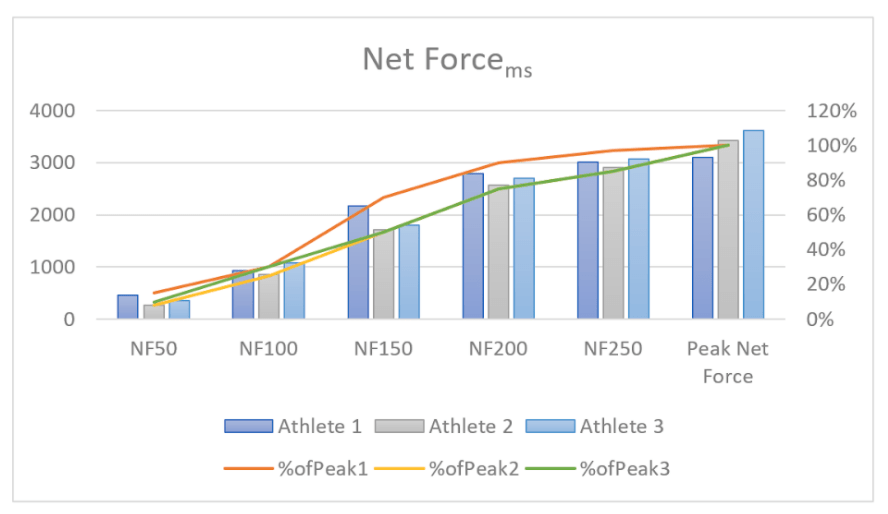Isometric Mid-Thigh Pull (IMTP) Strength Testing

If you haven’t read our High Performance assessment summary blog, it is a good place to start.
The Isometric Mid-Thigh Pull (IMTP) is a form of Multi-Joint Isometric Test (MJIT) and is useful for assessing athletes because of its safety, ease of application, and data quality.
The IMTP is performed on a dual force plate system with a barbell locked at mid-thigh height, with the athlete attempting to produce as much force as possible as quickly as possible.
Why We Use the IMTP
MJITs have shown less injury risk than traditional 1RM testing often implemented in strength assessments/reassessments. With the IMTP requiring less experience and lifting-skill to execute at maximum effort than a 1RM test, it is safer than loading up a back squat—especially for an athlete’s initial strength assessment when we have limited knowledge of their experience and capability.
The IMTP also shows limited benefit from familiarization, meaning that after the initial warm-up reps, the results show low variance between sessions. This is important because we want to test an athlete’s strength, not their technical competency at performing the test, making it practical for assessing an athlete of any experience level and evaluating athlete progress over extended periods of time. With the IMTP, we can be confident that a change in result is due to a change in strength, not due to a change in IMTP technique.
Research also shows that the IMTP is an accurate means of determining key metrics, including peak force, peak force relative to body weight, and force at specific times (such as 150, 200, 250, and 300 ms). This gives us information about the athlete’s maximal strength capacity and their rate of force development profile.
IMTP Protocol
- Measure the athlete’s bar height by setting their knee angle to 125° and their hip angle to 150°.
- Calibrate the force plates and weigh the athlete.
- Play an audible buzzer countdown with three short beeps and one three-second long beep signifying the start and duration of the pull. This lets the athlete know what to expect during the trials.
- Cue the athlete to:
- “Grip the barbell but do not create any tension until I say go.”
- “On the count of the buzzer, put as much force into the ground as fast as you can for the duration of the beep.”
- Have the athlete perform two trials, one at 75% RPE and one at 90% RPE for familiarization and warm-up.
- Perform three trials at maximum effort (any trials showing an unsteady baseline, countermovement at the onset of the rep, or peak force achieved at the very end of the effort are discarded).
- If the final trial is at least 250N greater than previous reps, we repeat for a 4th trial.
Why We Do it this Way
The IMTP’s effectiveness is heavily dependent on controlling as many variables outside the athlete’s change in strength as possible. Measuring key joint angles is an important first step, after which any subsequent testing is performed at the same bar height. We use 125° for the knee and 150° for the hip because these angles provide a strong and well-leveraged position for the knee, with the hip angle set to ensure an upright torso.
An upright torso is important for the IMTP because it allows for maximum force production and ensures that the lower body force production is not significantly limited by erector or trapezius strength. Removing potential limiters is also why we make use of figure-8 straps fixed to our IMTP bar. Grip strength has been shown to be a significant limiter to the IMTP PF, so using straps or an alternating grip is recommended.
We instruct the athlete to start with as little tension in the bar as possible because any tension can lead to an unsteady baseline or contribute to a counter-movement at the trial’s onset, which are both grounds for trial rejection. Both conditions alter RFD readouts from the test, and a counter-movement at the beginning of the rep is a significant issue because it allows the athlete to tap into the stretch-shortening cycle, which will help them generate more PF and produce higher RFD.
We also discard reps showing PF achieved at the very end of the effort because it indicates a yank action and a break in technique, not a true reading of their IMTP PF.
What Metrics We Look at
Net Peak Force (Net PF) is the first metric we look at from the IMTP. To calculate Net PF, we subtract bodyweight from PF. We use Net PF instead of Peak Force to more accurately compare between athletes and between retests, so that athlete weight differences or weight fluctuation do not skew any comparison. Net PF is used to gauge absolute strength and compare results to our facility average for a given athlete’s competition level.
Dividing Net PF by bodyweight gives a relative strength value—a good indicator if a person is strong relative to their body weight. We look to see PF over three times body weight. This metric is especially useful for athletes in a body-composition phase, either looking to gain weight or lose it. An athlete looking to add some muscle, for example, would want to see their relative peak force stay the same or increase because this means that their increased weight came with an increase in force production.
An overweight athlete may display high levels of absolute force but still have low relative strength because of the excess body fat they are carrying. If the athlete can minimize the strength lost during a body-composition phase, their relative strength should improve significantly.
Rate of force development in the IMTP
Rate of Force Development (RFD) can be a ‘noisy’ metric with a lot of variability from rep to rep, making it impractical for S&C practitioners as a direct measure of an athlete’s ability to produce force rapidly. Instead, we recommend using Net Force in early time intervals following the onset of the pull because it is more reliable and can be used as a proxy for RFD. If we take the Net Force at 50 ms intervals from 100 to 250 ms (e.g., @ 100-, 150-, 200-, 250 ms), we can still determine how quickly an athlete can increase force output without measuring RFD directly.

To take force at certain points one step farther, we can take the Net Force at these different points as a percentage of Net PF to compare RFD across trials or athletes. In the table and graph below, example athlete data shows how this could be visualized:

Looking at the data and graph, we can see that Athlete 1 has the highest RFD, which allows them to reach as much force in the first 250ms as either of the other two, despite a significantly lower Peak Net Force total. This could help us see more deeply into an athlete’s force production capability and give us more data to compare to pitcher/hitter performance.
How the IMTP Influences Programming
When it comes to using IMTP data to program for an athlete, we compare their Net PF to the mean for their level of competition per our facility data and generally look for a Net PF greater than 3000N.
An athlete who tests low in the IMTP demonstrates low absolute strength, so they will typically need a strength-focused training phase for their next block. If the athlete shows good absolute strength, we will look to the other parts of their strength assessment to get an accurate picture of their needs.
For example, if an athlete tests above 3000N in the IMTP but jumps a below average jump height in the countermovement jump, they may need a power-focused training phase. These are general standards for our IMTP data interpretation. Other factors, such as athlete age, training experience, off-season stage, health, etc., must also be considered when building the athlete’s strength program.
By Connor White, High Performance
Stone, Michael & O’Bryant, et al. (2019). “Using the Isometric Mid-Thigh Pull in the Monitoring of Weightlifters: 25+ Years of Experience”. 19-26.
Beckham, George K., “The Effect of Various Body Positions on Performance of the Isometric Mid-Thigh Pull” (2015). Electronic Theses and Dissertations. Paper 2544.
Keogh, Ciarán, et al. “Intra-Trial Reliability and Usefulness of Isometric Mid-Thigh Pull Testing on Portable Force Plates.” Journal of Human Kinetics, Sciendo, 31 Jan. 2020.
Beckham, George K., “The Effect of Various Body Positions on Performance of the Isometric Mid-Thigh Pull”.
Stone, Michael & O’Bryant, et al. “Using the Isometric Mid-thigh Pull in the Monitoring of Weightlifters: 25+ Years of Experience”
Jordan, Matt. “Mechanical Muscle Function Course.” Jordan Strength, 2019,
Keogh, Ciarán, et al. “Intra-Trial Reliability and Usefulness of Isometric Mid-Thigh Pull Testing on Portable Force Plates.” Journal of Human Kinetics, Sciendo, 31 Jan. 2020
Keogh, Ciarán, et al. “Intra-Trial Reliability and Usefulness of Isometric Mid-Thigh Pull Testing on Portable Force Plates.” Journal of Human Kinetics, Sciendo, 31 Jan. 2020

Comment section